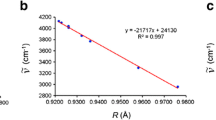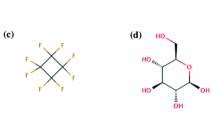Abstract
We studied microhydrated calcium thiosulfate and its ions at the restricted Hartree–Fock RHF/6-31G* level of theory. A semiempirical molecular dynamics search of progressively more hydrated species provided lowest-energy configurations that were then fully optimized and characterized as energy minima at the RHF/6-31G* level of theory. The first solvation shell of calcium thiosulfate contains 18 water molecules, while the first solvation shell of thiosulfate ion consists of 15 water molecules. QTAIM calculations show hydrogen bonding to sulfur. At 298.15 K, we estimate the total standard enthalpies of hydration for thiosulfate ion and calcium thiosulfate at infinite dilution as −301 kcal mol−1 and −335 kcal mol−1, respectively. The dissociation of hydrated calcium thiosulfate at infinite dilution is predicted to be an endothermic process with an enthalpy of 262 kcal mol−1. Based on some experimental data, the predominant form of calcium thiosulfate in solution is predicted to be the contact ion pair.

Hydrated calcium thiosulfate, showing the first solvation shell











Similar content being viewed by others
References
Sullivan DM, Havlin JL (1992) Thiosulfate inhibition of urea hydrolysis in soils-tetrathionate as a urease inhibitor. Soil Sci Soc Am J 56:957–960. doi:10.2136/sssaj1992.03615995005600030045x
Ohtaki H, Radnai T (1993) Structure and dynamics of hydrated ions. Chem Rev 93:1157–1204. doi:10.1021/cr00019a014
Robertson WH, Johnson MA (2003) Molecular aspects of halide ion hydration: the cluster approach. Annu Rev Phys Chem 54:173–213. doi:10.1146/annurev.physchem.54.011002.103801
Marcus Y (2009) Effect of ions on the structure of water: structure making and breaking. Chem Rev 109:1346–1370. doi:10.1021/cr8003
Liu C-W, Wang F, Yang L, Li X-Z, Zheng W-J, Gao YQ (2014) Stable salt–water cluster structures reflect the delicate competition between ion–water and water–water interactions. J Phys Chem B 118:743–751. doi:10.1021/jp408439j
Rohman N, Mahiuddin S (1997) Concentration and temperature dependence of ultrasonic velocity and isentropic compressibility in aqueous sodium nitrate and sodium thiosulfate solutions. J Chem Soc Faraday Trans 93:2053–2056. doi:10.1039/a700022g
Afanas’ev VN, Tyunina EY (2004) Structural features of ion hydration in sodium nitrate and thiosulfate. Russ J Gen Chem 74:673–678
Trinapakul M, Kritayakornupong C, Tongraar A, Vchirawongkwin V (2013) Active site of the solvated thiosulfate ion characterized by hydration structures and dynamics. Dalton Trans 42:10807–10817. doi:10.1039/c3dt50329a
Nelson J, Nieuwenhuyzen M, Pál I, Town RM (2004) Dinegative tetrahedral oxoanion complexation; structural and solution phase observations. Dalton Trans 15:2303–2308. doi:10.1039/b401200c
Steudel R, Steudel Y (2009) Microsolvation of thiosulfuric acid and its tautomeric anions [HSSO3]− and [SSO2(OH)]− studied by B3LYP-PCM and G3X(MP2) calculations. J Phys Chem A 113:9920–9933. doi:10.1021/jp905264c
Rosas-García VM, Sáenz-Tavera IC, Rodríguez-Herrera VJ, Garza-Campos BR (2013) Microsolvation and hydration enthalpies of CaC2O4(H2O) n (n = 0–16) and C2O4 2−(H2O) n (n = 0–14): an ab initio study. J Mol Model 19:1459–1471. doi:10.1007/s00894-012-1707-6
Hassinen T, Peräkylä M (2001) New energy terms for reduced protein models implemented in an off-lattice force field. J Comput Chem 22:1229–1242. doi:10.1002/jcc.1080
Hanwell MD, Curtis DE, Lonie DC, Vandermeersch T, Zurek E, Hutchison GR (2012) Avogadro: an advanced semantic chemical editor, visualization, and analysis platform. J Cheminform 4:17. doi:10.1186/1758-2946-4-17
Stewart JJP (2007) Optimization of parameters for semiempirical methods. V: Modification of NDDO approximations and application to 70 elements. J Mol Model 13:1173–1213. doi:10.1007/s00894-007-0233-4
Stewart JJP (2012) MOPAC2012. Stewart Computational Chemistry, Colorado Springs. http://OpenMOPAC.net, last date of access 15th Jan 2015
Schmidt MW, Baldridge KK, Boatz JA, Elbert ST, Gordon MS, Jensen JH, Koseki S, Matsunaga N, Nguyen KA, Su S, Windus TL, Dupuis M, Montgomery JA Jr (1993) General atomic and molecular electronic structure system. J Comput Chem 14:1347–1363. doi:10.1002/jcc.540141112
Neese F (2012) The ORCA program system. Wiley Interdiscip Rev Comput Mol Sci 2:73–78. doi:10.1002/wcms.81
Martínez L, Andrade R, Birgin EG, Martínez JM (2009) PACKMOL: a package for building initial configurations for molecular dynamics simulations. J Comput Chem 30:2157–2164. doi:10.1002/jcc.21224
Jmol Development Team (2012) Jmol: a 3D molecular visualizer. http://www.jmol.org, last accessed 15 Jan 2015
Persistence of Vision Pty. Ltd. (2004) Persistence of Vision raytracer (version 3.6). http://www.povray.org/download/, last accessed 15 Jan 2015
GIMP Development Team (2009) GNU Image Manipulation Program (GIMP) v.2.6.7. http://www.gimp.org, last date of access 15th Jan 2015
Kelly CP, Cramer CJ, Truhlar DG (2006) Adding explicit solvent molecules to continuum solvent calculations for the calculation of aqueous acid dissociation constants. J Phys Chem A 110:2493–2499. doi:10.1021/jp055336f
Tang E, Di Tommaso D, de Leeuw NH (2010) Accuracy of the microsolvation–continuum approach in computing the pK a and the free energies of formation of phosphate species in aqueous solution. Phys Chem Chem Phys 12:13804–13815. doi:10.1039/C0CP00175A
Tian L, Chen F (2012) Multiwfn: a multifunctional wavefunction analyzer. J Comput Chem 33:580–592
Xenides D, Randolf BR, Rode BM (2006) Hydrogen bonding in liquid water: an ab initio QM/MM MD simulation study. J Mol Liq 123:61–67. doi:10.1016/j.molliq.2005.06.002
Desiraju GR (2011) A bond by any other name. Angew Chem Int Ed 50:52–59. doi:10.1002/anie.201002960
Bader RFW (1990) Atoms in molecules—a quantum theory. Oxford University Press, Oxford
Ochterski JW (2000) Thermochemistry in Gaussian. http://www.gaussian.com/g_whitepap/thermo.htm, last accessed 15 Jan 2015
Paniagua C, Mota Valeri F (2010) Dipòsit Digital de la UB. U. de Barcelona, Barcelona. http://diposit.ub.edu/dspace/handle/2445/13382, last accessed 15 Jan 2015
Woon DE Jr, Dunning TH Jr (1995) The pronounced effect of microsolvation on diatomic alkali halides: ab initio modeling of MX(H2O) n (M = Li, Na; X = F, Cl; n = 1–3). J Am Chem Soc 117:1090–1097. doi:10.1021/ja00108a027
Lane JR, Contreras-García J, Piquemal J-P, Miller BJ, Kjaergaard HG (2013) Are bond critical points really critical for hydrogen bonding? J Chem Theory Comput 9:3263–3266. doi:10.1021/ct400420r
Elerman Y, Fuess H, Joswig W (1982) Hydrogen bonding in magnesium thiosulphate hexahydrate MgS2O3 ·6H2O. A neutron diffraction study. Acta Crystallogr B 38:1799–1801. doi:10.1107/S0567740882007225
Manojlović-Muir LA (1975) A neutron diffraction study of barium thiosulphate monohydrate, BaS2O3 ·H2O. Acta Crystallogr B 31:135–139. doi:10.1107/S0567740875002245
Llsensky GC, Levy HA (1978) Sodium thiosulfate pentahydrate: a redetermination by neutron diffraction. Acta Crystallogr B 34:1975–1977. doi:10.1107/S0567740878007116
Platts JA, Howard ST, Bracke BRF (1996) Directionality of hydrogen bonds to sulfur and oxygen. J Am Chem Soc 118:2726–2733. doi:10.1021/ja952871s
Dean JA (ed)(1985) Lange’s handbook of chemistry, 13th edn. McGraw-Hill, New York, pp 4–37, Table 4–4
Gimblett FGR, Monk CB (1955) Spectrophotometric studies of electrolytic dissociation. Part 1. Some thiosulphates in water. Trans Faraday Soc 51:793–802. doi:10.1039/TF9555100793
Acknowledgments
The authors wish to acknowledge funding from Universidad Autónoma de Nuevo León through the PAICyT program (grants #CN067-09 and #CA1731-07), and from Facultad de Ciencias Químicas.
Author information
Authors and Affiliations
Corresponding author
Electronic supplementary material
Below is the link to the electronic supplementary material.
ESM 1
(DOC 236 kb)
Rights and permissions
About this article
Cite this article
Rosas-García, V.M., Sáenz-Tavera, I. & Rojas-Unda, M. Microsolvation and hydration enthalpies of CaS2O3(H2O) n (n = 0–19) and S2O3 2−(H2O) n (n = 0–16): an ab initio study. J Mol Model 21, 98 (2015). https://doi.org/10.1007/s00894-015-2638-9
Received:
Accepted:
Published:
DOI: https://doi.org/10.1007/s00894-015-2638-9




